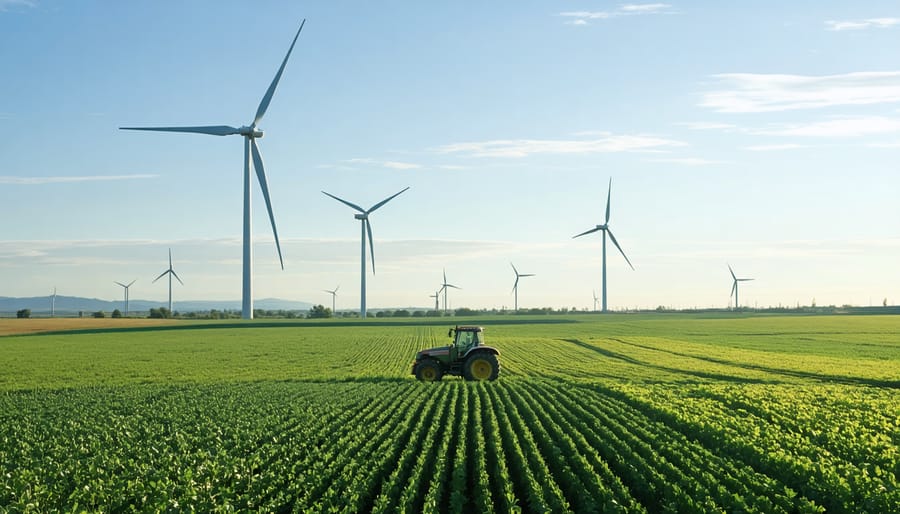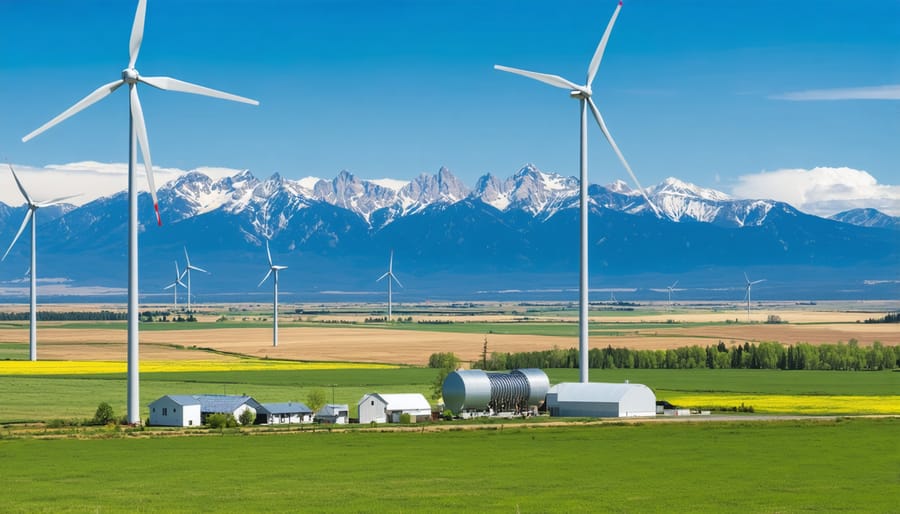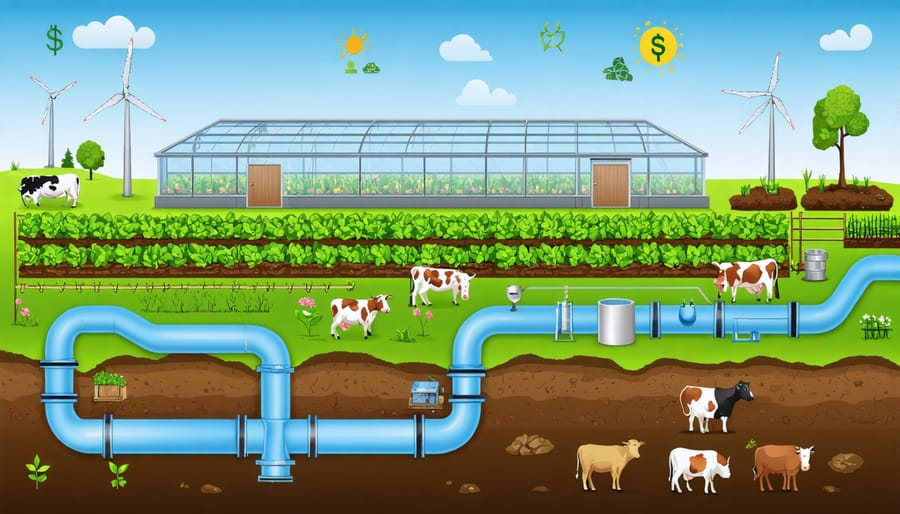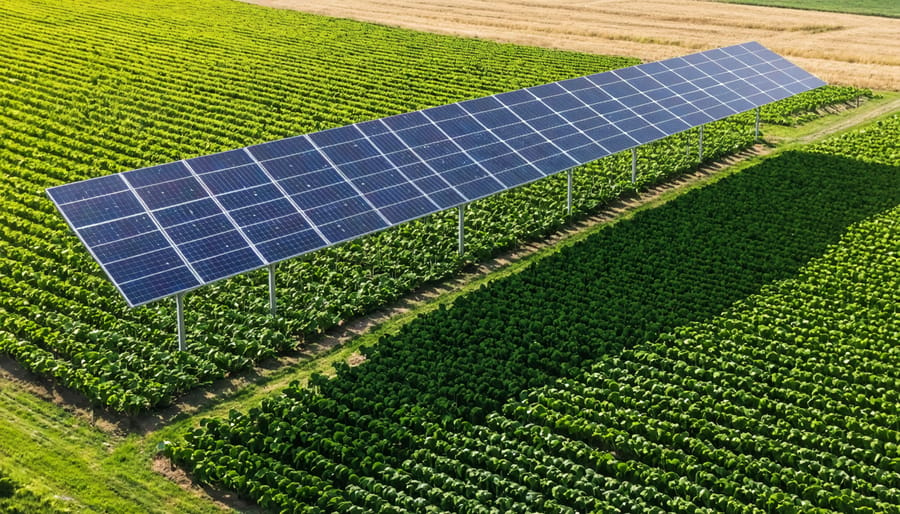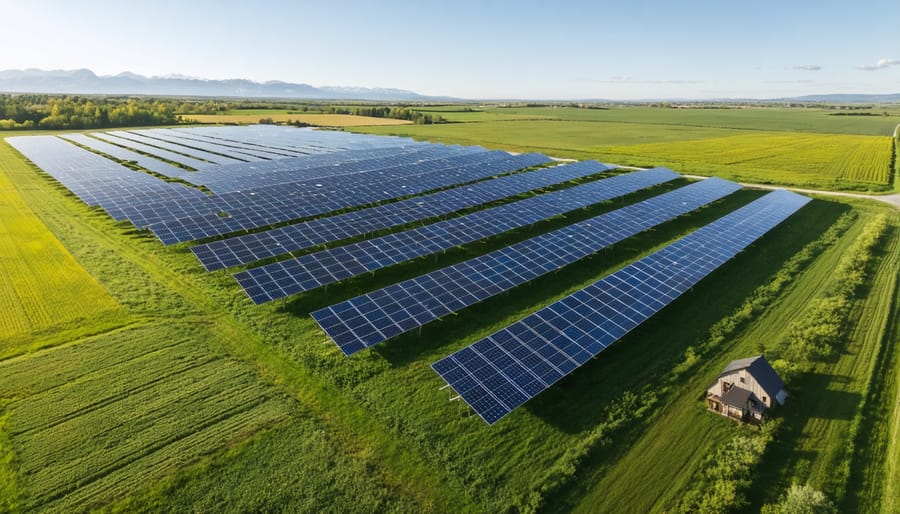Transform your farmland into a sustainable energy powerhouse by establishing wind farm foundations that harmonize with agricultural operations. As renewable energy systems reshape Alberta’s agricultural landscape, wind turbine foundations offer farmers a robust pathway to energy independence while maintaining productive cropland. Modern foundation designs now accommodate both deep-rooted crops and heavy machinery, requiring just 1-2% of total farm acreage while generating consistent revenue throughout the year. Canadian farmers implementing these hybrid energy-agriculture systems report 15-25% increases in annual farm income, with foundation designs specifically engineered to withstand Prairie frost depths and varying soil conditions. This practical guide walks through essential considerations for integrating wind energy infrastructure with existing agricultural operations, focusing on soil compatibility, seasonal impacts, and maximum land-use efficiency.
Understanding Wind Farm Foundation Basics for Agricultural Land
Foundation Types Suitable for Alberta Soil Conditions
Alberta’s unique soil conditions, ranging from clay-rich deposits to sandy loam, require carefully selected foundation types for wind turbine installations. Based on extensive field studies and local engineering expertise, three foundation designs have proven particularly effective in our province.
The most common choice for Alberta farms is the gravity-based foundation, which works exceptionally well in our prairie soil conditions. These foundations typically extend 2-3 metres deep and use a wide concrete base to distribute the turbine’s weight. For farms with clay-dominant soil, which is common in central Alberta, this foundation type provides excellent stability while minimizing excavation costs.
In areas with looser soil compositions, particularly in southern Alberta’s sandy regions, deep pile foundations offer superior performance. These foundations extend 15-20 metres into the ground, providing robust anchoring against our strong chinook winds. Local farmers have reported excellent long-term stability with this option, despite the higher initial installation costs.
For locations with shallow bedrock, which we often see in western Alberta near the foothills, rock-anchored foundations are the go-to choice. These foundations use specialized anchoring systems drilled directly into the bedrock, requiring less concrete while maintaining optimal stability.
Working with local geotechnical engineers is crucial for determining the most suitable foundation type for your specific location. Soil testing should be conducted at multiple depths to ensure the chosen foundation design aligns with your farm’s unique soil profile.
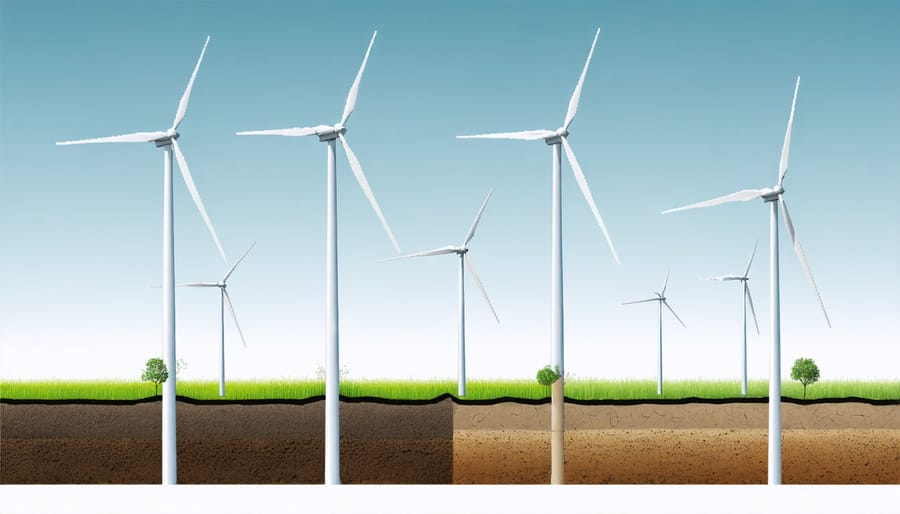
Impact on Farmland and Crop Production
Wind farm foundations typically occupy only 1-2% of the total land area, allowing farmers to continue cultivating crops right up to the base of the turbines. In Alberta, many farmers have found that the space between turbines creates ideal conditions for growing wheat, canola, and other staple crops.
According to local farmer Mike Thompson from Pincher Creek, “We’ve been farming around wind turbines for over a decade now. The foundations are well-designed to minimize impact, and we can easily maneuver our equipment around them during seeding and harvest.”
The concrete foundations are usually buried beneath topsoil, maintaining valuable growing space. Modern foundation designs incorporate drainage systems that prevent water pooling, which helps protect surrounding crops from excess moisture. During construction, contractors typically implement soil protection measures to prevent compaction and maintain soil health.
Some farmers have reported additional benefits, such as using access roads for more efficient field operations and the wind break effect of turbines helping to reduce soil erosion. The key is proper planning during the initial layout phase to ensure turbine placement aligns with existing farming patterns and equipment requirements.
Site Assessment and Planning
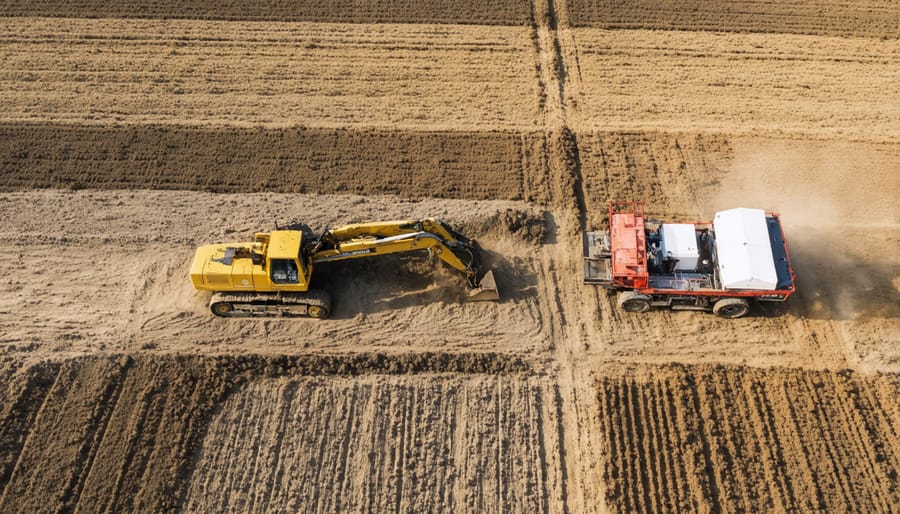
Soil Testing and Geological Considerations
Before any wind turbine foundation can be established, thorough soil testing and geological surveys are essential to ensure long-term stability and safety. Here in Alberta, our diverse soil conditions require careful consideration, from the clay-rich soils of central regions to the sandy compositions found in southern areas.
Local farmers should work with qualified geotechnical engineers who’ll conduct comprehensive soil investigations, typically including bore samples taken at depths of 15 to 30 metres. These tests analyze crucial factors like soil bearing capacity, moisture content, and frost susceptibility – all vital for our prairie climate.
The geological assessment looks at bedrock depth, groundwater levels, and potential soil settlement issues. For Alberta farms, special attention needs to be paid to areas with previous oil and gas activity or natural resource extraction that might affect underground stability.
Key tests include standard penetration tests (SPT), cone penetration tests (CPT), and laboratory analysis of soil samples. The results determine the foundation type needed – whether it’s a gravity base, rock anchor, or pile foundation system.
As Tom Anderson, a third-generation farmer from Red Deer, shares, “Getting proper soil testing done saved us significant costs down the line. We discovered unexpected clay formations that required foundation adjustments, but catching this early prevented future problems.”
Remember, seasonal variations in soil conditions, particularly during spring thaw and heavy rain periods, should be factored into the analysis.
Environmental Impact Studies
Before breaking ground on a wind farm foundation project, Alberta farmers must complete comprehensive environmental impact studies and secure necessary permits. These assessments typically evaluate several key factors, including soil composition, wildlife habitats, and potential effects on local ecosystems.
The process begins with a detailed site assessment conducted by qualified environmental consultants. They examine how the foundation construction might affect local drainage patterns, soil stability, and groundwater resources. Special attention is paid to protecting native grasslands and minimizing disruption to existing agricultural operations.
Farmers need to work with their local county or municipal district to obtain land-use permits, which often require documentation of environmental mitigation strategies. The Alberta Utilities Commission (AUC) also requires environmental studies as part of their approval process for wind energy projects.
Key environmental considerations include:
– Bird and bat migration patterns
– Impact on soil productivity
– Wetland protection measures
– Noise and shadow flicker assessments
– Archaeological significance
Most studies take 6-12 months to complete, depending on seasonal wildlife observations required. Successful applications typically include plans for post-construction land reclamation and ongoing environmental monitoring.
Local agricultural extension offices can provide guidance on finding qualified environmental consultants familiar with both wind energy development and agricultural land preservation requirements. Many farmers find that proper environmental planning leads to better project outcomes and stronger community support.
Cost Analysis and ROI for Alberta Farmers
Initial Investment and Installation Costs
The initial investment for wind farm foundations typically ranges from $250,000 to $400,000 per turbine in Alberta, with costs varying based on soil conditions and foundation type. Concrete foundations, the most common choice among Canadian farmers implementing sustainable farm energy solutions, require approximately 400-600 cubic metres of concrete and 40-50 tonnes of reinforcing steel per turbine.
Labour costs generally account for 15-20% of the total foundation expense, including site preparation, form work, and concrete pouring. Equipment rental, including cranes and specialized machinery, adds another 10-15% to the budget. Site-specific factors like soil testing ($5,000-$8,000) and engineering studies ($15,000-$25,000) are essential preliminary investments.
For Alberta farmers, winter construction may increase costs by 5-10% due to concrete heating requirements and extended working hours. However, many farmers find that scheduling foundation work during the agricultural off-season helps minimize disruption to farming operations. Local contractors often offer package deals that include both foundation work and access road construction, potentially reducing overall costs by 8-12% compared to separate contracts.
Long-term Benefits and Energy Savings
Installing wind farm foundations on agricultural land creates substantial long-term financial benefits for farmers across Alberta. Studies show that a properly maintained wind turbine foundation can support energy generation for 20-25 years, significantly reducing on-farm electricity costs. Many farmers report savings of 40-60% on their annual energy bills after installation.
Beyond direct energy savings, wind turbines create additional income streams through power purchase agreements with utility companies. Farmers can sell excess electricity back to the grid, generating steady revenue while maintaining regular farming operations. When combined with wind energy storage solutions, farms can maximize their energy efficiency and increase their return on investment.
The foundation’s durability also means minimal maintenance costs over its lifetime. Most farmers report annual maintenance expenses of less than 2% of the initial installation cost. Additionally, wind farm foundations often qualify for various provincial and federal renewable energy incentives, further improving the long-term financial outlook.
Several Alberta farmers have achieved complete energy independence within 8-10 years of installation, while continuing to generate income through power sales. This combination of reduced operating costs and new revenue streams has proven particularly valuable during challenging agricultural seasons.
Success Stories: Alberta Farms Leading the Way
The Thompson Family Farm Experience
Located just outside of Pincher Creek, the Thompson Family Farm has become a shining example of successful wind energy integration in Southern Alberta’s agricultural landscape. In 2018, John and Sarah Thompson made the bold decision to incorporate wind turbines into their 1,200-hectare cattle and grain operation.
Working closely with local renewable energy experts, the Thompsons installed three 2.5-megawatt turbines, carefully positioning them to minimize impact on their farming activities. The foundation work, completed during the winter months to avoid disrupting spring seeding, required extensive soil testing and engineering to ensure stability in the region’s challenging chinook wind conditions.
“We were initially concerned about how the turbines might affect our cattle,” explains Sarah Thompson. “But after three years, we’ve noticed our herds are completely at ease grazing right up to the base of the structures.” The family has maintained productive cropland around the turbines, losing only 0.3 hectares per installation.
The project has generated significant benefits for the farm’s operations. The Thompsons now earn approximately $45,000 annually through their power purchase agreement, providing stable income during challenging agricultural years. They’ve also seen unexpected advantages, such as improved snow distribution across their fields due to the turbines’ effect on wind patterns.
The success of the Thompson project has inspired neighboring farms to explore similar initiatives. “It’s about finding that sweet spot between agricultural production and renewable energy,” John Thompson notes. “For us, it’s meant greater financial security without compromising our farming heritage.” The family regularly hosts educational tours for other Alberta farmers interested in wind energy integration, sharing their practical insights and experience-based recommendations.

Lessons Learned from Pioneer Wind Farmers
Alberta’s wind farm pioneers have valuable insights to share from their decades of experience integrating turbines with agricultural operations. Third-generation farmer Mike Thompson from Pincher Creek emphasizes the importance of thorough site assessment before installation. “We spent six months monitoring wind patterns and consulting experts. That initial investment in planning saved us significant headaches later,” he explains.
Several successful wind farmers stress the value of community engagement. Sarah McKenzie, who manages a 400-hectare operation near Lethbridge, credits her project’s success to early discussions with neighbours. “Transparency and open dialogue helped address concerns before they became issues,” she notes.
Maintenance planning has proven crucial for long-term success. Experienced operators recommend establishing dedicated maintenance schedules and building relationships with qualified technicians. This proactive approach has helped many farmers maintain optimal farm energy efficiency while minimizing downtime.
Another key lesson involves wildlife protection measures. Installing bird flight diverters and maintaining appropriate setbacks from sensitive habitats has helped farmers balance energy production with environmental stewardship. Many report that these measures have actually enhanced their land’s biodiversity.
The most consistent advice from pioneers is to view wind energy as a long-term investment. “It’s not about quick returns,” says James Morrison, whose family farm near Medicine Hat has operated turbines for 15 years. “Think of it as infrastructure that will benefit future generations while supporting sustainable farming practices today.”
Successful operators also emphasize the importance of flexible lease agreements that protect both landowner and developer interests, ensuring fair compensation while maintaining agricultural access to the land.
As we’ve explored throughout this guide, wind farm foundations offer Canadian farmers a powerful opportunity to diversify their income while contributing to sustainable agriculture. The key takeaways show that successful implementation requires careful planning, from site assessment and soil testing to navigating regulatory requirements and securing financing.
For Alberta farmers considering this venture, the next steps are clear. Begin by conducting a preliminary wind resource assessment of your property and consulting with local agricultural extension offices. Connect with neighboring farmers who have already implemented wind energy solutions to learn from their experiences. The Alberta Wind Energy Association offers valuable resources and can connect you with qualified contractors and consultants.
Remember that funding options are available through federal and provincial clean energy initiatives, and many financial institutions now offer specialized loans for renewable energy projects. Consider starting with a smaller pilot project to understand the operational impacts on your farming activities before scaling up.
The future of Canadian agriculture lies in innovation and sustainability. By incorporating wind energy into your farming operation, you’re not just creating an additional revenue stream – you’re helping build a more resilient agricultural sector for future generations. Reach out to your local agricultural cooperative or renewable energy association to begin your wind farm foundation journey today.
For personalized guidance and support, contact your regional agricultural office or attend one of the regularly scheduled renewable energy workshops in your area.

